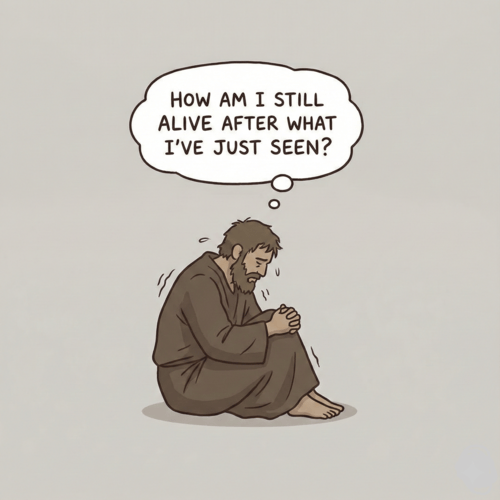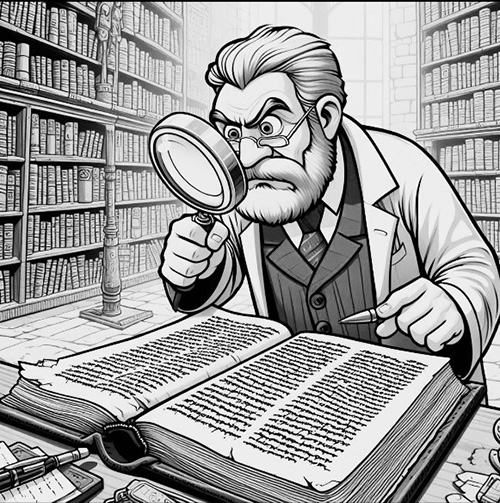Who Wrote the Fourth Gospel? Was It Indeed John?
The Gospel of John stands apart from the other three canonical gospels. Its distinctive theological depth, literary style, and unique stories have fascinated readers for centuries. But a crucial question remains: who actually wrote this remarkable text? While sceptical scholars have questioned traditional views, substantial evidence supports John’s authorship.
The question matters deeply. If John’s Gospel comes from an eyewitness and apostle who walked with Jesus, its historical reliability and theological authority carry significant weight. So this isn’t merely an academic exercise but touches on how we understand Jesus himself.
WHO WROTE THE FOURTH GOSPEL? INTERNAL EVIDENCE
The Gospel itself provides our first clues about its authorship. Most notably, the text refers repeatedly to “the disciple whom Jesus loved” (John 13:23, 19:26, 20:2, 21:7, 21:20). In the final chapter, this beloved disciple is explicitly identified as the source behind the Gospel (John 21:24)
While never naming himself directly (a common practice in ancient writings), the internal evidence strongly suggests this beloved disciple was John. Consider these facts:
- The ‘beloved’ disciple was among the inner circle at the Last Supper (John 13:23-25)
- He stood at the cross with Jesus’ mother (John 19:26-27)
- He ran with Peter to the empty tomb (John 20:2-8)
- He was among the seven disciples fishing in Galilee after the resurrection (John 21:7)
Only three disciples consistently appear in Jesus’ innermost circle: Peter, James, and John. The text clearly distinguishes this figure from Peter, and James died too early to have authored the Gospel. This points squarely to John.
Also supporting John’s authorship is the remarkable geographical and cultural accuracy throughout the text. The author demonstrates intimate knowledge of:
- Palestinian topography (including obscure locations like Aenon (John 3:23)
- Jewish customs and festivals
- Jerusalem’s layout before its destruction in 70 AD
- Specific details like the five porticoes at the Pool of Bethesda (John 5:2), confirmed by modern archaeology
These details suggest the author wasn’t just familiar with Palestine but witnessed these places personally—consistent with John’s experience as a Galilean fisherman who travelled extensively with Jesus.
WHO WROTE THE FOURTH GOSPEL? EARLY CHURCH TESTIMONY
The external evidence from early church leaders provides even stronger confirmation of John’s authorship.
- Irenaeus of Lyon (c. 130-202 AD) explicitly states: “John, the disciple of the Lord, who also leaned on his breast, published a Gospel during his residence at Ephesus in Asia.” This testimony carries particular weight because Irenaeus was a disciple of Polycarp, who was himself a disciple of John—creating a direct line back to the apostle.
- Clement of Alexandria (c. 150-215 AD) similarly confirmed John’s authorship, adding that John wrote last among the evangelists, composing a “spiritual Gospel” to complement the more narrative accounts of the Synoptics.
- The Muratorian Fragment (c. 170 AD), our earliest canonical list, attributes the Fourth Gospel to “John, one of the disciples,” explaining that when fellow disciples and bishops urged John to write, he agreed to do so after they all fasted and received confirmation.
- Justin Martyr (c. 100-165 AD), while not naming John explicitly, quotes from the Fourth Gospel and attributes it to apostolic “memoirs,” indicating its early acceptance as apostolic in origin.
What’s also remarkable is the complete absence of any competing traditions about the Gospel’s authorship in the early church. Despite theological controversies where challenging John’s authorship would have been advantageous to some groups, no ancient source attributes this Gospel to anyone else.
ARCHAEOLOGICAL AND HISTORICAL CONFIRMATION
Archaeological discoveries continue to validate the author’s intimate knowledge of pre-70 AD Jerusalem and Palestine.
The discovery of the Pool of Siloam in Jerusalem, the Pool of Bethesda with its five porticoes, and accurate references to locations such as Jacob’s Well all confirm the text’s historical reliability. This accuracy extends to customs, religious practices, and political details about Roman governance in Judea.
Among the most compelling archaeological evidence is Papyrus 52 (P52), a fragment of John’s Gospel dated to approximately 125-175 AD. This remarkably early manuscript fragment—found in Egypt, far from Ephesus—demonstrates the Gospel’s wide circulation within a single generation of its traditional dating, making a pseudonymous attribution highly unlikely.
ADDRESSING COMMON OBJECTIONS
Several objections to Johannine authorship deserve consideration:
Objection 1: The sophisticated Greek and theological depth seem beyond a Galilean fisherman.
Response: John, however, likely had decades to develop his Greek skills while ministering in Ephesus. Additionally, bilingualism was common in first-century Palestine. The theological depth reflects not education but spiritual maturity developed over a lifetime of reflection on Jesus’ teachings.
Objection 2: The style differs dramatically from Revelation, also attributed to John. Response: Different scribes or amanuenses could account for stylistic differences between works. Additionally, different genres (apocalyptic versus biographical) naturally produce different writing styles, even from the same author.
Objection 3: The Gospel was written too late for John’s authorship.
Response: Even with late dating (80-95 AD), John could have been in his 70s or 80s—entirely possible for authorship. Early dating (60-70 AD) would resolve this concern entirely.
Objection 4: The “anti-Jewish” tone seems inconsistent with an apostle to the Jews.
Response: The Gospel reflects tensions between Jesus-followers and synagogue authorities at the end of the first century, not anti-Semitism. John, as an apostle who witnessed the early conflicts, would have understood these tensions firsthand.
THE APOSTOLIC COMMUNITY THEORY
A nuanced understanding of authorship acknowledges John as the authoritative source while recognising the potential involvement of a Johannine community in the Gospel’s final form.
This “community theory” suggests John’s testimony was treasured and preserved by his disciples in Ephesus. The first-person plural in John 21:24 (“We know that his testimony is true”) hints at this community’s involvement in preserving and possibly arranging John’s recollections.
This model allows for the possibility that while John provided the eyewitness testimony and core content, disciples may have helped arrange and possibly transcribe his teachings—especially if he was of advanced age. This explains both the Gospel’s eyewitness quality and its polished literary features.
Far from undermining Johannine authorship, this understanding strengthens it by accounting for both the text’s apostolic origin and its final literary form.
CONCLUSION: WHO WROTE THE FOURTH GOSPEL?
The evidence for John’s authorship of the fourth Gospel is remarkably strong—much stronger than sceptical voices often acknowledge. The internal claims of eyewitness testimony, the text’s detailed accuracy about pre-70 AD Palestine, the unanimous early church tradition, and archaeological confirmations all point to Johannine authorship.
When we read the words “these are written that you may believe that Jesus is the Christ, the Son of God, and that by believing you may have life in his name” (John 20:31), we can trust we’re hearing the testimony of someone who walked with Jesus, leaned against his chest at the Last Supper, stood at the foot of his cross, and, indeed, witnessed the empty tomb. John’s Gospel truly is an eyewitness testimony to the life, death, and resurrection of Jesus Christ.
WHO WROTE THE FOURTH GOSPEL? RELATED FAQs
Why does John emphasise “love” so much, and how might this connect to his own experience? Love appears in John’s Gospel nearly four times more frequently than in any other Gospel, culminating in Jesus’ new commandment to “love one another.” As the self-described “beloved disciple,” John found his identity in being loved by Christ, suggesting his own transformation from being a “son of thunder” into the “apostle of love.” Having been entrusted with the care of Jesus’ mother (John 19:26-27), he developed a unique perspective on familial love and responsibility. Some scholars suggest John’s emphasis on love reflects his own spiritual journey. As the disciple who identified himself by Jesus’ love for him rather than by name, John found his identity in being loved by Christ. His Gospel and epistles suggest this experience transformed him from being one of the “sons of thunder” (Mark 3:17) into the “apostle of love.”
- What unique stories about Jesus appear only in John’s Gospel? John alone presents Jesus turning water into wine, speaking with Nicodemus about being “born again,” meeting the Samaritan woman at the well, raising Lazarus, washing the disciples’ feet, and Thomas’ post-resurrection doubt. These unique accounts provide essential insights into Jesus’ character and relationships that aren’t found in the Synoptic Gospels.
- What are the “I AM” statements in John, and why are they significant? John records seven profound “I AM” declarations where Jesus identifies himself using metaphors such as “the bread of life,” “the light of the world,” and “the way, the truth, and the life.” These statements echo God’s self-revelation to Moses (Exodus 3:14), providing some of Scripture’s clearest claims to Jesus’ divinity. These statements, too, are unique to the fourth gospel.
- How does John’s portrayal of Jesus differ from the Synoptic Gospels? John presents a more explicitly theological portrait focusing on Jesus’ divine pre-existence, relationship with the Father, and identity as the incarnate Word. Unlike the Synoptics, John features longer philosophical discourses instead of parables and structures his narrative around seven miraculous “signs” revealing Jesus’ glory.
- Did John write his Gospel for a specific audience or purpose? John explicitly states his purpose: “These are written that you may believe that Jesus is the Christ, the Son of God” (John 20:31). Evidence suggests he wrote for multiple audiences including Jewish Christians facing synagogue exclusion, Greek-speaking Gentile converts, and those confronting early heresies about Jesus’ nature.
- Why does John include so many references to “the Jews” in seemingly negative contexts? John uses “the Jews” about 70 times, often referring specifically to religious leaders opposed to Jesus, not the Jewish people as a whole. This reflects tensions between Jewish Christians and synagogue authorities at the time of writing, speaking as an insider to an internal Jewish debate, not as an outsider condemning Judaism.
What evidence exists for John’s long life and ministry in Ephesus? Early church traditions consistently place John in Ephesus during his later years, with Irenaeus noting he lived until Emperor Trajan’s reign (98-117 AD). This extended life would explain the Gospel’s mature theological reflection and its unique ability to address both Jewish and Greek audiences through decades of ministry.
WHO WROTE THE FOURTH GOSPEL? OUR RELATED POSTS
- Dating of the Gospels: The Case for Pre-70 AD Authorship
- Are the Gospels Eyewitness Accounts? The Mounting Evidence
- Who Wrote the Gospels? Evaluating Modern Scholarship
Editor's Pick

The Throne-Room Vision: Who Did Isaiah See?
The scene is unforgettable: Isaiah stands in the temple, and suddenly the veil between heaven and earth tears open. He [...]

The Angel of the Lord: Can We Be Certain It Was Christ All Along?
Throughout the Old Testament, a mysterious figure appears: the Angel of the LORD. He speaks as God, bears God’s name, [...]
SUPPORT US:
Feel the Holy Spirit's gentle nudge to partner with us?
Donate Online:
Account Name: TRUTHS TO DIE FOR FOUNDATION
Account Number: 10243565459
Bank IFSC: IDFB0043391
Bank Name: IDFC FIRST BANK






